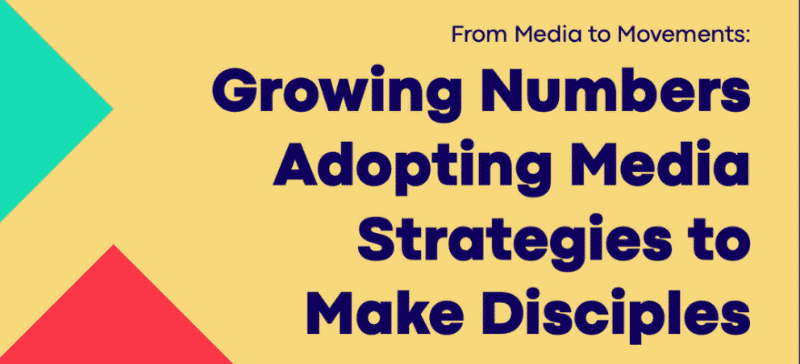Growing Numbers Adopting Media Strategies to Make Disciples


By Dr. Frank Preston and Dr. Gordon Bonham in partnership with the Media to Movements training coalition with Marti Wade.
The Vision: Leveraging Media to Start Disciple-Making Movements
People search for everything online. Good recipes, driving directions, quick fixes, and not-so-quick fixes—even answers to life’s biggest questions. As people seek answers online, we want them to find gospel truth and connect with people who can disciple them. Because the reality is that most people will not feel satisfied with a brief blog post or YouTube video. They want wisdom from a source they can trust. They are not simply asking for solutions to their question, they are asking whether or not someone is there to answer.
God has given us the platform of digital media to share his good news with the world. It is already used daily by the vast majority of the world’s population. That’s why now is a great window of opportunity to leverage media to initiate disciple-making movements.
We call it media to movements (MTM).
Media to movements is the strategic use of digital media to identify people on a spiritual journey to Christ and connect them with local disciple-makers who, in turn, equip them to reach their family and friends with the gospel.
These strategic initiatives help spiritual seekers find disciple-makers and help disciple-makers find spiritual seekers. MTM practitioners use contextualized websites and/or social media platforms to share media presentations, engage those who respond in digital conversations, assess their spiritual readiness, and arrange personal contact between the spiritual seeker and a trained disciple-maker. The disciple-maker will then help the seeker discover, obey, and share about Jesus, often by gathering a few friends or family members to study scripture and live it out together.
Ultimately, the goal is to see disciple-making movements: multiple streams of four or more “generations” of multiplying disciples within three to five years of the first generations. Though by this definition, no MTM efforts have yet resulted in a complete disciple-making movement, many initiatives are seeing encouraging fruit and some have produced multiple generations of new believers.
Media to Movements Training
A growing number of ministries provide training in MTM strategies. By 2018 half a dozen of them came together to form a training coalition. By the end of 2019, as many as 600 people had participated in one or more training courses offered by coalition members. In 2020, the coalition saw a 35% increase in the number of people participating in training programs. By the end of the year, the number of people trained had grown to approximately 950.
Interest in this type of ministry is steadily increasing. Some groups are already passing training on to others. By April 2021, the coalition made a conservative estimate that 119 ministry teams around the world had implemented MTM strategies and 90 more teams were being trained and coached to begin. Many individual disciple-makers are also using their personal social media accounts to engage in evangelistic outreach.
MTM efforts have been further advanced through the international collaboration between networks, organizations, and churches all around the globe. In several parts of the world, practitioners have formed hubs to share best practices and resources in similar contexts and across organizational lines. Currently, there are hubs in East Asia, Southeast Asia, South Asia, and Europe.
A Global Research Report
On April 21, 2021, the coalition released its 2021 Media to Movements Training Coalition Research Report, building on a report which explored challenges and best practices and was released in 2020. For the 2021 research, invitations to complete a survey were sent to 646 people who had participated in training courses. Of these, 107 (17%) completed the survey. Researchers also conducted in-depth interviews with ten of the survey participants.
Survey participants represented a wide array of organizations and worked in a variety of contexts, though 69% of them were seeking to reach Muslims (a decrease from 75% of those who participated in the 2020 survey). Few were focused on reaching Hindus or secularists, though both these groups had higher representation in the 2021 research than the 2020 research.
First Fruits: Increased Engagements with Spiritual Seekers
Eight out of ten survey participants who had implemented their plans said they are seeing “many” or “quite a lot” of engagements, with 64% reporting more face-to-face meetings with people who were spiritual seekers, and—though to less degree—more conversions, baptisms, and disciples who were leading others to faith.
Moving forward, disciple-makers may need more coaching in the transition from online engagement with seekers to relationship-based disciple-making. The establishment of more regional hubs to share ideas and information could be very helpful at this point.
What about the Pandemic?
The COVID-19 pandemic forced many cross-cultural workers to suddenly leave their fields of service. Media strategies, however, often benefited from the changes brought by the pandemic. Workers who were on lockdown or separated from their fields were forced to think creatively about ministry strategies and how best to use their time. Many invested in training they might not have pursued if traditional strategies had been an option. This year’s survey showed that those who had not already launched a media strategy struggled to progress in developing one during this season. Yet a majority of those who already had a media strategy in place reported greater fruit, with 58% reporting that the pandemic positively impacted their work. Only 8% of this population said it had a negative impact.
One put it this way:
“It validated our efforts before the pandemic. God had given this vision and plan, so we were ready to reach out to people during the pandemic. … MTM became the major form of our outreach as other ways of meeting people were drastically impacted by the pandemic. Honestly, it was really a God thing to bring our MTM team together right before that hit.”
Moving from a Dream to a Plan to a Practice
Leveraging media to start disciple-making movements may seem straightforward, but it requires perseverance, creative innovation, and a commitment to the development process. One participant compared it to a marathon, not a sprint, and advised others to prayerfully assess whether they are ready to “build the tower” (Luke 14:28). Yet the recent survey suggests a steadily increasing level of implementation. More than half of those who participated in both years’ surveys—people who were therefore involved in MTM ministry to some extend for at least two years—had progressed to a higher stage of implementation and fruitfulness from 2020 to 2021.
Though only 7% of those who participated in the 2020 survey had fully developed their media strategies at the time of the survey, the 2021 survey showed an increase to 19%. 17% of the participants reported that they had had fully implemented their MTM plans—an increase from 8% in the previous survey. In 15% of cases, these plans were fully integrated into their team strategies, while an additional 47% reported integration was in process. This integration is a vital factor to increase the likelihood of persistence and fruitfulness. More than half of those who were implementing their strategies reported a fully implemented plan for prayer, specifically—another key factor.
The Role of Coaching
Roughly half of all who completed the survey had someone coaching them through their MTM process. “Get a coach” was the top recommendation MTM practitioners who completed the survey had for those who might be considering MTM ministry. Coaches help those just getting started to develop an appropriate strategy and navigate common hurdles such as understanding their audience, developing appropriate materials, raising funds, learning new technologies, setting up tracking systems, and avoiding pitfalls. Coaches can help those who are further along to stay focused, track the most helpful data, encourage face-to-face meetings, and help disciples become disciple-makers themselves. Some MTM practitioners are now facing the challenge of having too many contacts without a clear strategy for transforming evangelistic fruit into the multiplication of disciples who make disciples.
We can expect, as social media patterns and policies continue to evolve, implementing digital outreach strategies will become more difficult. If so, coaching may become even more crucial. MTM practitioners are unlikely to see the fruit they desire without good training, encouragement, and support.
Survey respondents, especially those in the earlier stages of implementation, also advised those considering an MTM strategy to experiment, “keep trying,” and “stick to it.” In the earliest stages of implementation, many practitioners are juggling competing priorities and may struggle to put in the necessary time to launch and sustain an MTM ministry. Clear communication about roles and responsibilities, accountability, and prayer help build a strong foundation for success.
One participant wrote,
“Come up with an end-to-end strategy before you get too far. Think of your goals and purpose and don’t get distracted. Find a good coach or mentor who can walk with you through this. Don’t be afraid to try things and fail.”
Accelerating Adoption of MTM Strategies in the Mission Community
Decades ago, communications professor Everett Rogers wrote the book Diffusion of Innovations, which popularized a model for how ideas spread. This in use today, this model describes the adoption of any innovation in terms of a bell curve. The first 2.5% to adopt a strategy, product, or idea are called innovators, and growth is slow at this point. They are followed by early adopters (the next 13.5%) and an early majority (34%), ultimately leading to a 50% adoption rate and the top of the bell curve before the acceleration of adoption slows.
By December 2020, a leader in the coalition estimated that, based on available data, about 7% of missionaries focused on unreached people groups were using media-based strategies to varying degrees. The numbers continue to grow, with researchers now estimating that adoption of these strategies has surpassed 13% and could be approaching 20%. In Rogers’ model, this places the implementation of media-based strategies in the phase of early adoption.
As we look towards the second half of 2021, several factors are in place to facilitate exponential growth:
- Members of the frontier mission community tend to be a tight-knit group with many characteristics in common. They tend to share ideas that bear fruit with others in their networks. This is a positive environment for the continued expansion of MTM strategies.
- Global trends and innovations related to technology, including the use of mobile phones and social media, also make the MTM strategy ripe for adoption.
- Recently, many disciple-makers have been highly restricted and government surveillance on the rise in some locations. This has heightened interest in new strategies for finding people open to religious change without compromising security.
If the rate of adoption of MTM strategies has passed 13%, we have good reason to believe it could quickly rise to 50%—a critical milestone in the diffusion of innovations.
The evidence that this is beginning to happen is encouraging. One mission organization set a goal to see 50 teams in a certain region trained in MTM strategies by the end of 2021. By the end of the first quarter of 2021, 25 of the 50 teams had begun MTM strategy implementation. Another large mission organization plans to have 25% of its teams launch media strategies by 2025.
Learn More
For the full report and more information about Media to Movements, watch the Executive Summary at visualstory.org/mtmsurvey21. If you are interested in learning how you can accelerate disciple-making movements in a specific context, contact us through the website mediatomovements.org or by email at info@mediatomovements.org.
This article is submitted by Clyde Taber of Visual Story Network. Visual Story Network is a Missio Nexus member. Member organizations can provide content to the Missio Nexus website. See how by clicking here.





Responses